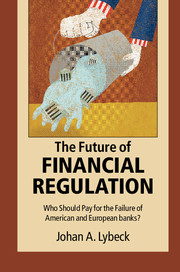Book contents
- Frontmatter
- Dedication
- Contents
- List of figures
- List of tables
- List of boxes
- Preface
- Acknowledgements
- List of abbreviations
- Introduction
- Part I A chronological presentation of crisis events January 2007 – December 2014
- Part II Bail-out and/or bail-in of banks in Europe: a country-by-country event study on those European countries which did not receive outside support
- Part III Bail-out and/or bail-in of banks in Europe: a country-by-country event study on those European countries which received IMF/EU support
- Part IV The TARP program and the bailing out (and bailing in) of US banks
- Part V Summary of the micro studies
- Part VI Political and regulatory responses to the crisis: to bail out or to bail in, that's the question
- Conclusion: toward host-country supervision and resolution?
- Addendum
- Bibliography
- Index
Addendum
Published online by Cambridge University Press: 05 February 2016
- Frontmatter
- Dedication
- Contents
- List of figures
- List of tables
- List of boxes
- Preface
- Acknowledgements
- List of abbreviations
- Introduction
- Part I A chronological presentation of crisis events January 2007 – December 2014
- Part II Bail-out and/or bail-in of banks in Europe: a country-by-country event study on those European countries which did not receive outside support
- Part III Bail-out and/or bail-in of banks in Europe: a country-by-country event study on those European countries which received IMF/EU support
- Part IV The TARP program and the bailing out (and bailing in) of US banks
- Part V Summary of the micro studies
- Part VI Political and regulatory responses to the crisis: to bail out or to bail in, that's the question
- Conclusion: toward host-country supervision and resolution?
- Addendum
- Bibliography
- Index
Summary
As this book goes to press, the Financial Stability Board has complemented the earlier work by the Basel Committee on Banking Supervision with a proposal for minimum levels of bailinable debt in the banks regarded as too big to fail, or in Basel-speak, globally systemically important financial institutions (G-SIFIs). Since the proposal is still on the drawing-board, I will limit myself to the bare bones as regards this new concept, total loss-absorbing capital (TLAC).
Above the presently decided capital requirements under Basel III, i.e.
• 4.5% minimum CET1/RWA
• 2.5% Capital Conservation Buffer in the form of CET1
• 1% other Tier 1 capital
• =8% Minimum Tier 1 capital
will be added an additional
• +8–12% Loss absorbing capital (subordinated debt, CoCos…) Since the large banks are also subject to a
• 1–2.5% SIFI charge
and may be subject to a
• 0–2.5% countercyclical buffer
It implies that the G-SIFIs will have to hold, at the discretion of the supervisory authority, 17–25 percent capital in relation to riskweighted assets. They must also hold a minimum of 6 percent TLAC in relation to total (unweighted) assets, of which at least 3 percent must be CET1.
It has been calculated that there will be a need to issue 480–1,600 billion dollars in Contingent Convertible securities (CoCos) and other Basel III-approved bailinable debt to satisfy the new requirements.
However, it is difficult to see that the proposal, while a step in the right direction, solves the problems highlighted in this book. Foremost, the threat to bail in even senior debt holders in a systemic crisis is not credible. As a bank reaches a position where a bail-in becomes possible, a run on its debt will ensue which will increase funding costs for all (large) institutions. Some evidence of the nervousness of investors in bailinable debt has already begun to appear. The solution, as put forward by Anat Admati, Martin Hellwig, Andy Haldane and many others, is to demand a much higher proportion of equity in the capital requirements.
- Type
- Chapter
- Information
- The Future of Financial RegulationWho Should Pay for the Failure of American and European Banks?, pp. 487 - 488Publisher: Cambridge University PressPrint publication year: 2016



